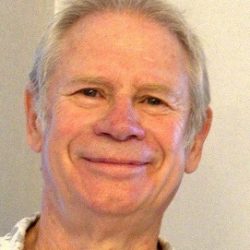Back to the Balaenoptera – the first investigation into whaling that led to the creation of EIA
Next year will see EIA celebrate its 40th anniversary, but 40 years ago this month the three young activists who would go on to create the organisation were aboard a North Sea trawler conducting their first investigation into Norwegian whaling …
My brother, hanging off the side of a rust-bucket trawler, paintbrush in hand, waved as I drove my VW camper into London’s West India Dock. Peter was painting a large minke whale on the bow of this latest madcap idea to go to sea to document the cruel Norwegian whaling industry.
I say madcap because I’m definitely not a seaman. Four years earlier, I had been persuaded by Allan Thornton, then director of Greenpeace, to be a photographer on the Rainbow Warrior on the high seas off Iceland.
My seasickness had been appalling, only getting some relief when the nurse gave me seasick suppositories (nothing is good about this story). I had seen my first living whale, a fin whale, killed a couple of hours later. Our intervention and documentation soon forced us back to Reykjavik for weeks of boat arrest. So, you might understand my distrust of boats.
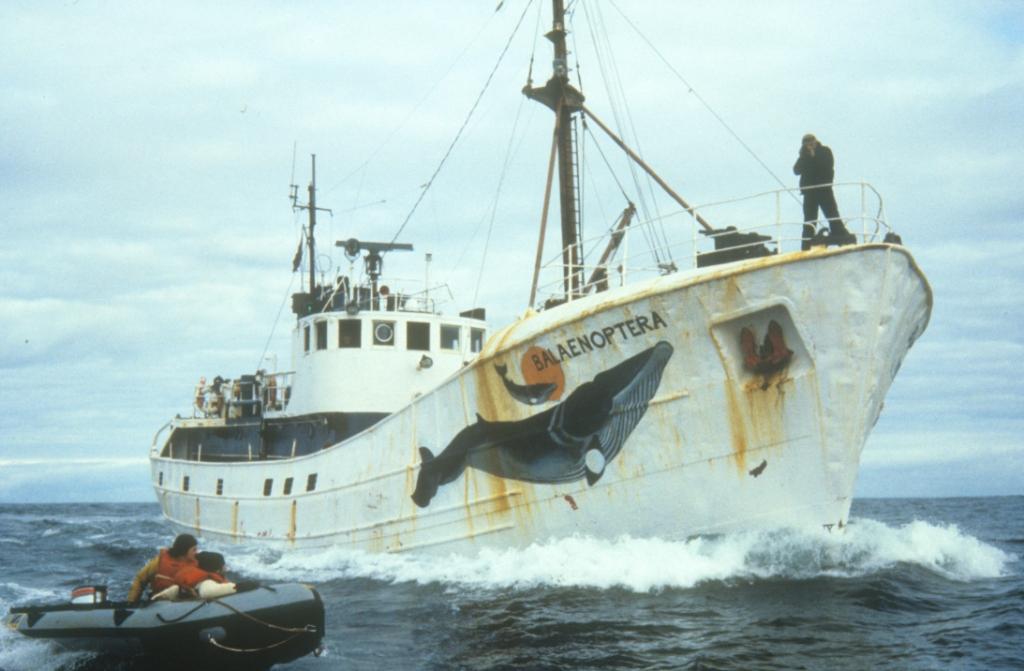
Nevertheless, as long as this particular rust-bucket named ‘Balaenoptera’ was in dock, I was keen to help. So, armed with enthusiasm, I helped paint, clean and generally prepare the boat for its single mission in the Barents Sea, in the Arctic Circle. My partner, Gary, and our border collie Jaff would visit and there was a great camaraderie between all the volunteers. On one occasion, Jaff fell from the gang plank many metres into the dock and swam like crazy to avoid being squashed as the boat moved on its mooring ropes. Linking arms, we managed to rescue him from certain death. Boats. Definitely for other people.
Anti-whaling had been the battle cry of the burgeoning environmental movement in the 1970s, which had culminated in a 1982 decision by the International Whaling Commission for a moratorium on commercial whaling to start in 1986. The cold harpoon (non-explosive, but propelled by a cannon) had also been banned because of its inhumane cruelty. Norway had registered an objection to the moratorium, legally exempting its industry from the global moratorium.
One of the volunteers on the boat was Jenny Gibson (now Lonsdale), who had helped Allan buy the boat in Aberdeen and sail it down to London. She had known him from Greenpeace California days and was enthusiastically mucking in with everyone else.
I slowly saw the volunteer crew come together from Allan’s Greenpeace friends, such as skipper John Castle as well as experienced seamen who just wanted to help expose the horrors of whaling. However, I noticed that Allan hadn’t yet found a photographer.
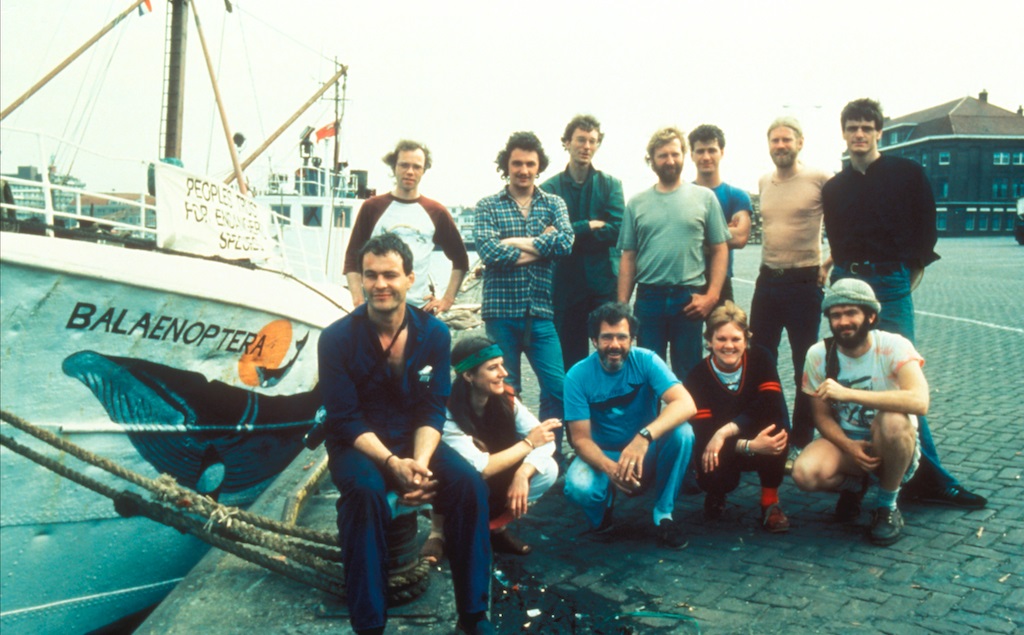
The Balaenoptera crew with EIA co-founders Dave and Allan Thornton, back row right, and Jenny, kneeling second from right
“Are you sure you don’t want to come?” Allan kept nudging me towards the six-week boat trip. Since I’m writing this, you already know I eventually caved in.
Early one dank grey Sunday morning in June 1983, two people wearing waterproofs and wellies were dropped off a Zodiac onto a jetty at a small Norwegian town in the Arctic Circle called Vardø. As the inflatable slowly moved away, the two of them turned and faced a five-metre fence.
“Not a good start,” remarked Jenny. We both started laughing. The Balaenoptera was still offshore and we had come to find out anything we could about the whaling industry. We had one day before our cover would be blown.
After noisily clambering over the fence, we realised our clandestine arrival had probably been noticed so, to be legal, we visited the local police station and announced our arrival. We were a little nervous but found them to be more bemused than threatening. Jenny with her notebook and pen, me with my Nikons, we explained we were journalists interested in knowing more about the whaling industry.
At this time of year, the sun never sets in the Arctic Circle and we found this small town gently bustling. Shops were open, the massive golf ball-shaped radar station (watching Russia) ominously sat on the hill above the town. We were to learn that nothing really stops at this time of year.
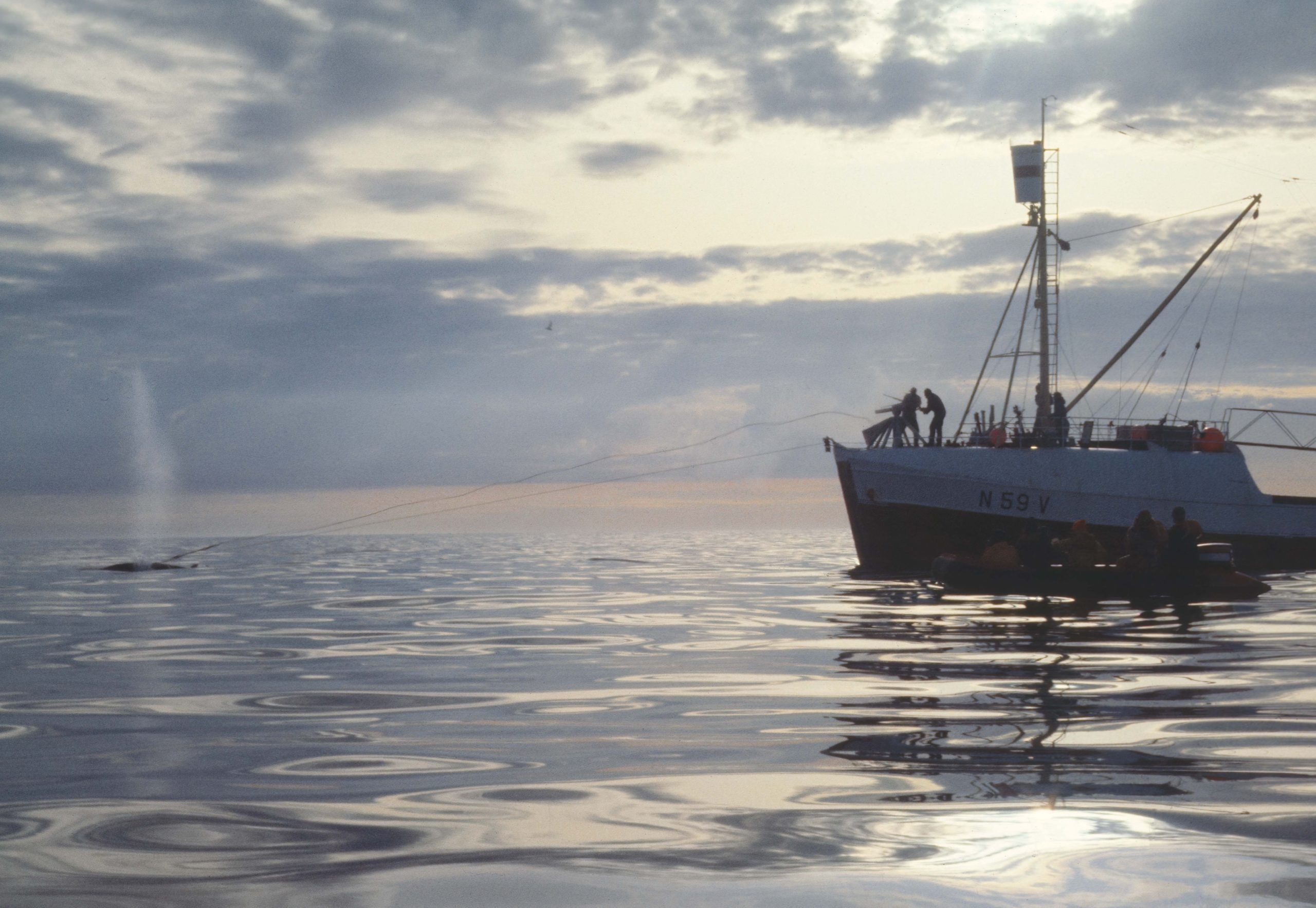
Norwegian vessel harpooning a minke whale
Just down the road we found the whale processing and packing factory. Locals stood behind counters packing the whale meat into boxes, watched intently by two Japanese men. The factory director came to speak with us and, although a little suspicious, he openly discussed the whaling business as well as allowing me to wander around taking photos.
There was a general small-town friendliness in Vardø; even the Japanese men happily agreed to have dinner with us later in the main hotel. Strangers were evidently an unusual sight and we had a few conversations with people working on the small whaling boats. With employment scarce, some of them explained it was the only work available. They told us where they hunted and, to our surprise, explained they even went into the grey zone between Russia and Norwegian waters.
Arriving at the hotel for dinner, having no extra clothes with us, we sat down with the two Japanese men in our waterproofs and wellies. We heard of their whale meat imports to Japan and the younger one’s doubt that the industry would survive. They also made it clear that Japanese companies were buying all the commercially produced whale meat in the world, except whatever was consumed locally in Norway.
The information, contacts and photographs were more than we could have hoped for. Just as we were wondering what to do with ourselves until the Balaenoptera blew our cover the next morning, the factory director found us and invited us to a party at his house.
I’ve been in this situation many times over years, accepting the kindness of the people I was investigating. It acts as a great reminder that peoples’ circumstances often dictate their deeds and Vardø is a whaling and fishing town. I’ve sometimes felt guilty about my deceit, but when undercover you have to become the person you’re pretending to be.
Accepting the invitation, we had a wonderful night with his family and friends, drinking under the midnight sun.
A Dutch TV film crew joined the Balaenoptera in Vardø. Yvonne Habets, a well-known TV presenter in the Netherlands, had enthusiastically agreed with Allan to broadcast a piece on the Balaenoptera’s trip. This was a vital part of our campaign to put pressure on Norwegian whaling. Our 24-hour visit to this northern Norwegian town eased the access for the film crew to the whale factory and an interview with the director.
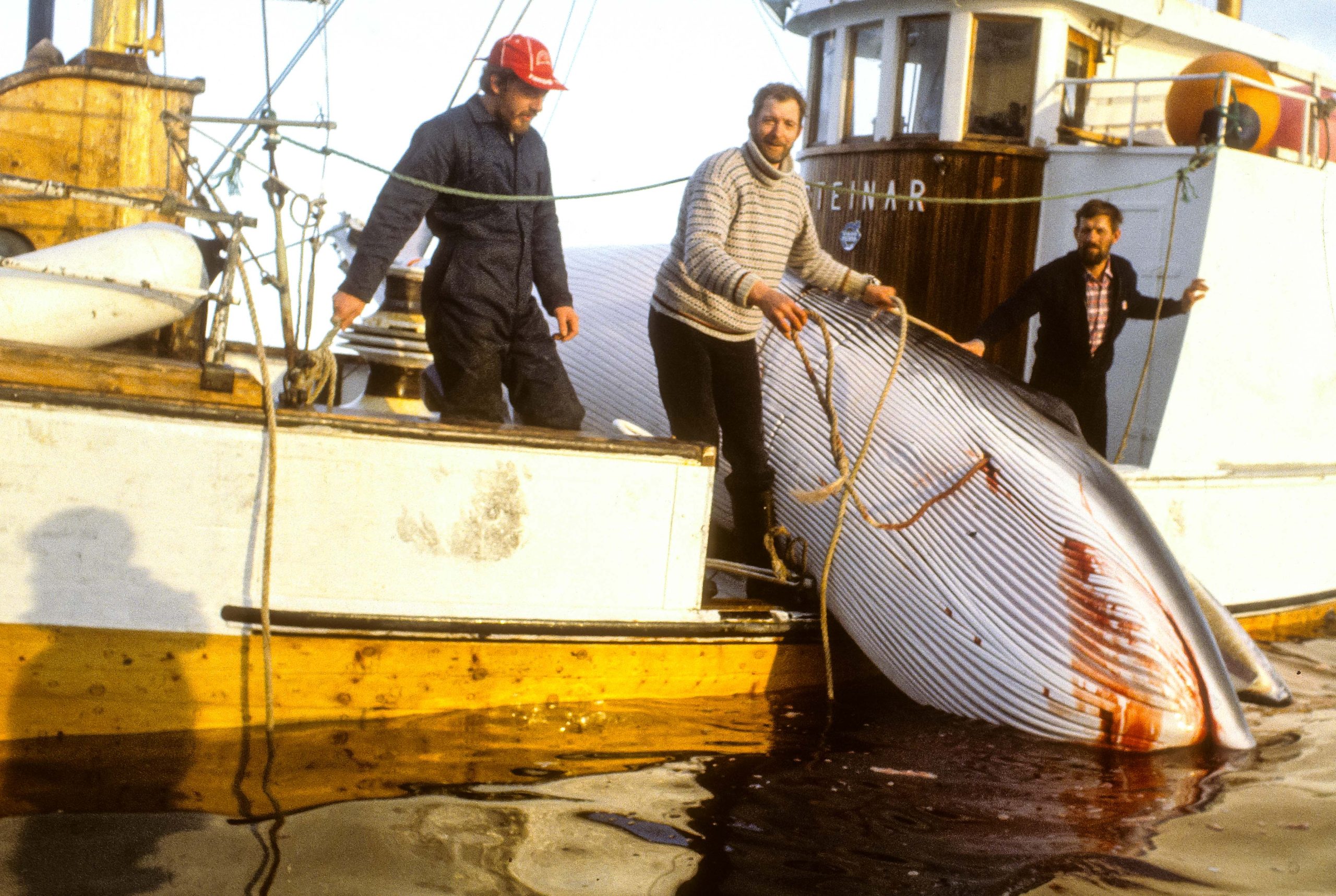
Whalers hauling a minke whale aboard
We all rejoined the boat and, although the whales painted on the bow of the ship had exposed our real purpose, we sailed out into the Barents Sea with a quiet sense that everything was going to plan.
The Barents Sea lies off the far north of Norway and Russia and its southern waters never freeze over. We searched for whaling boats all day and night and when we were near them our two Zodiacs were launched. I spent many hours in an inflatable with my seasickness at bay on the beautiful, completely calm, mirrored water. The film crew were in another inflatable. We watched as the whalers hunted and after a few days witnessed the harpooning of a minke whale.
The crack of the cannon and the unravelling of the rope attached to the harpoon preceded the sound of the harpoon smashing into the hapless whale.
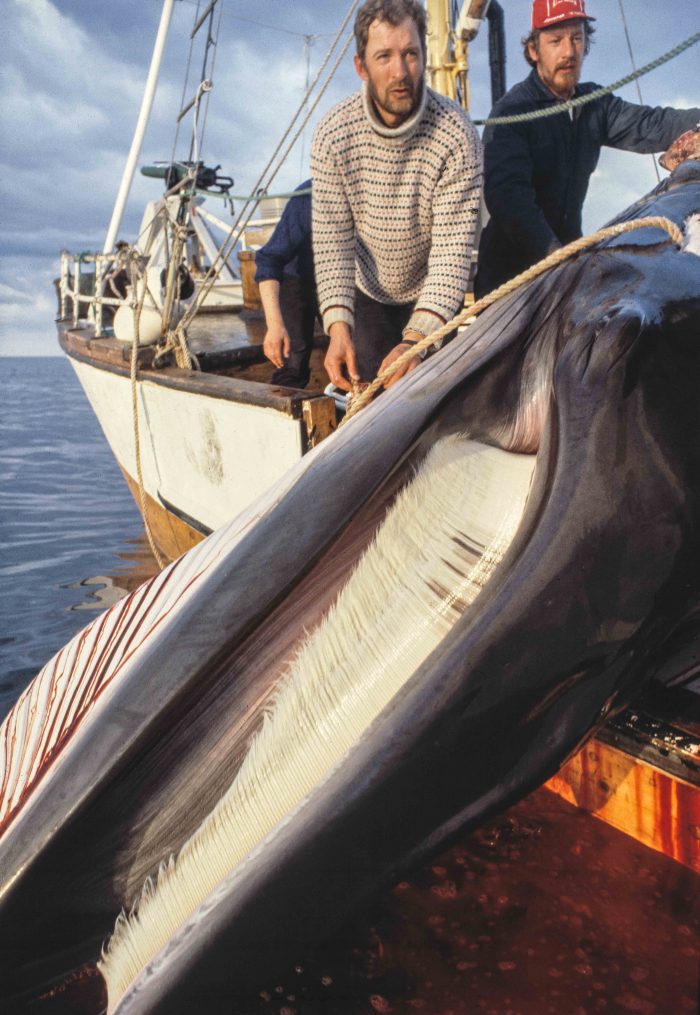 She tried to dive but, severely injured and probably pregnant, was unable to go far with the rope still attached to the boat. I felt extreme sadness, but our job of documenting this cruel hunt was overriding. The whalers winched their exhausted victim towards their boat, taking shots at her with a rifle. We drove our inflatable closer to the whaler and as I photographed her dead body bleeding over the boat’s deck, I knew we had the valuable evidence we needed for our campaign.
She tried to dive but, severely injured and probably pregnant, was unable to go far with the rope still attached to the boat. I felt extreme sadness, but our job of documenting this cruel hunt was overriding. The whalers winched their exhausted victim towards their boat, taking shots at her with a rifle. We drove our inflatable closer to the whaler and as I photographed her dead body bleeding over the boat’s deck, I knew we had the valuable evidence we needed for our campaign.
In the 40 years since this bloody encounter, I’ve seen environmental and wildlife horrors on hundreds of occasions. I’ve acutely felt that same moment when I know I’ve got the information and documentation needed to help build a campaign against this abuse. It’s an exhausting experience when the elation and profound sense of loss pull me apart.
We later sailed to the grey zone towards Russia and into a force 12 storm, with the bridge icing up, driving rain and violent squalls. Our first mate later told me that at one time we were vertical on a huge wave and he’d never seen anything like it. I was living my worst nightmare in a bunk. Shortly after this, I left the ship in the far north and headed back to the UK to process the film. I rejoined the vessel at the press conference in Amsterdam, just after Yvonne Habet’s powerful film was broadcast.
The footage, information and photos travelled the world in newscasts and magazines. As a result, the Norwegians cut their annual quota of whales from about 2,000 by two-thirds and agreed to comply with banning the cold harpoon.
For the next few years, the numbers killed remained very low and for a few years they stopped the killing altogether. But sadly, Norway still objects to the global moratorium and now hunts minke whales with explosive harpoons, albeit the numbers killed are still very much lower than in 1983.
It really is possible to make change with a madcap idea, a rust-bucket boat and a bunch of motivated volunteers. The wellies were back in action in the summer of 1984 in the Faroe Islands for more horror, wading through a sea reddened with pilot whale blood.
Months later, feeling compelled to continue making change and understanding the campaign value of unique environmental investigations, Allan, Jenny and I founded EIA.


